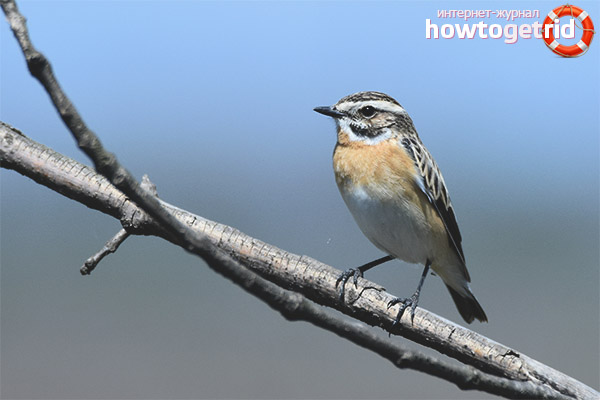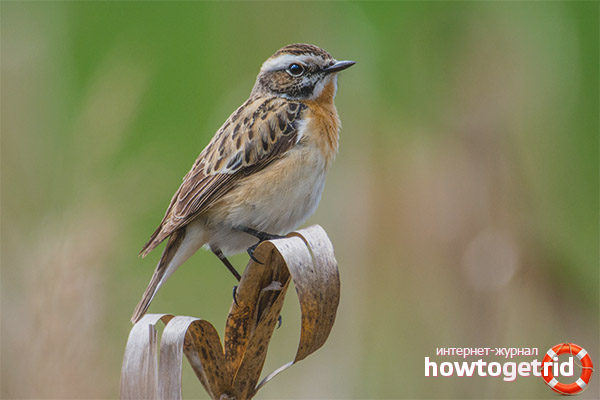The content of the article
The bird chasing bird belongs to the thrush family. In size they are even smaller than a sparrow. The body reaches about 12-14 cm in length. The wingspan of these birds is 23-24 cm. They have a short tail. The birds weigh 16-20 g.
The plumage in the upper body is brown in color, but streaks of a lighter shade are visible. On the lower part, the color of the plumage of the coin is light. And in the chest area the color is red. On the head there is a brown band, which begins near the beak and passes through the eye. And above the eye, the color of the plumage is light in the form of an eyebrow.
In males, the plumage is painted in brighter colors than in females. In the chest area there is a spot of a yellowish tint. The head is brown. The mint of a meadow foot and beak are gray. The eyes are dark. Young individuals are almost the same color as females. But they are more colorful.
Habitat
Representatives of this species live in Eurasia. Many of these birds live in Europe. But south of 43 ° north latitude you will not find these birds. A lot of them live on the territory of Russia. Here they can be seen from Arkhangelsk to the Caucasus itself. And in the territory of Western Siberia, meadow minters live up to the headwaters of the Yenisei.
Habitat
As a rule, these birds settle in meadows, where rather tall grass grows. Sometimes they live in rare shrubs. Rigid stalks of grass and bushes serve as squats for them.
Individuals that live in southern Europe often settle in glades with high humidity. They also live in the mountains, where they can be seen on pastures. Another favorite bird habitat is the edge of the coniferous mountain forest. Usually these are forests growing at high altitudes - up to 2000 m. When they fly to wintering places, they can stop in the fields to find food for themselves.
Vote
It is thanks to the sounds that these birds make that they got their name. This is an alarming scream that can be described as a “check-check”. These sounds, which are very similar to crackling, are made by birds when they are disturbed or alarmed. By this characteristic cod, the bird can be distinguished from others. The individual does not differ in beauty, therefore, representatives of this species are not referred to songbirds.
In the spring, the male displays short trills, but they are quiet. In these trills you can hear many imitative sounds.
Migrations
Representatives of the species of meadow minting are migratory birds. From the territory of Eurasia for the winter they fly to hot Africa. They spend winter in the equatorial regions of the continent. It returns to its usual nesting site only in late spring. At this time, a lot of fresh grass is already growing in the meadows. Birds live on nesting places until August, and then again fly away to Africa.
On average, these birds live about 6-8 years.
Breeding

These birds place their nests directly on the ground, choosing a place among the tall grasses. In search of food, these birds often walk on the surface of the earth, but at the same time they do not leave fingerprints.
The socket in its design is quite simple. Often minted equip them at the base of horse sorrel. Sometimes they can choose another plant with a large stiff stalk. The nest of the meadow mint is a hole of small depth - about 9 cm or more. Sometimes it is 2 times deeper. The average tray size is 6-4 cm.The bird lines it from the inside with dry grass and moss. Sometimes it can be lined with animal hair. The nest does not rise to the ground. The bird builds it in such a way that in appearance it completely merges with the surrounding area, and it was very difficult to notice. Blades of grass hang over it, which further protect the nest from prying eyes. Thanks to this, it’s very difficult to discern the nest of this bird.
The size of the nest depends on which hole the bird chooses. When it is built, and the bird is sure that it has masked well, it lays its eggs. In one masonry, their number is about 6-7 pieces. They look very beautiful, bright. Painted in a greenish blue color. As a rule, no speck on them. But sometimes small brown spots are visible. The size of the egg averages 20x15 mm. The female is engaged in hatching. It takes about 12-14 days. The bird sits tightly on the nest; it is very difficult to make it fly away. You can scare her only if you go too close, and the bird feels that you can step on it. The male at this time does not fly far, but is nearby. In case of danger, he warns the female.
Food
In the diet of meadow coinage there is animal food. They eat spiders, insects, larvae. Sometimes eat shellfish and worms. They love various berries. To find prey, the bird sits on top of the bush and looks out for the prey. If it detects prey, it flies down or pecks it from the foliage. The bird sometimes hunts in the air. Here she catches flies and small butterflies. When the victim is caught, the bird again sits on the bush or finds another place.
These birds benefit man, as they eat pests.
Video: Meadow Mint (Saxicola rubetra)










Submit